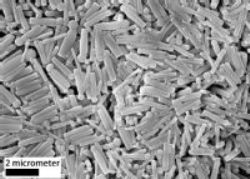Sep 11 2013
Chemists, physicists and computer scientists at the University of Warwick have come together to devise a new powerful and very versatile way of controlling the speed and direction of motion of microscopic structures in water using what they have dubbed chemically ‘motorised microscopic matchsticks’.
 Scientists have devised a new way to control the speed and direction of motion of microscopic structures in water using what they have dubbed chemically "motorized microscopic matchsticks." Credit: Stefan Bon, University of Warwick
Scientists have devised a new way to control the speed and direction of motion of microscopic structures in water using what they have dubbed chemically "motorized microscopic matchsticks." Credit: Stefan Bon, University of Warwick
Before now most research seeking to influence the direction of motion of microscopic components have had to use outside influences such as a magnetic field or the application of light. The University of Warwick team have now found a way to do it by simply adding a chemical in a specific spot and then watching the microscopic matchstick particles move towards it, a phenomenon known as chemotaxis.
The research published in the journal Materials Horizons (RSC) in a paper entitled Chemotaxis of catalytic silica–manganese oxide “matchstick” particles found that by adding a small amount of a catalyst to the head of a set microscopic rods, they could then cause the rods to be propelled towards the location of an appropriate ‘chemical fuel’ that was then added to a mixture.
For the purposes of this experiment the researchers placed silica–manganese oxide ‘heads’ on the matchstick material and introduced hydrogen peroxide as the chemical fuel in one particular place.
They placed the ‘matchsticks’ in a mixture alongside ordinary polymer microspheres.
When the hydrogen peroxide was added the microspheres continued to move in the direction of convection currents or under Brownian motion but the matchsticks were clearly rapidly propelled towards the chemical gradient where the hydrogen peroxide could be found.
The reaction was so strong that more than half of the matchstick particles did not reverse their orientation once over their 90 seconds of travel towards the hydrogen peroxide – even though they were contending with significant convection and Brownian rotation.
University of Warwick research chemical engineer Dr Stefan Bon who led the research said:
“We choose high aspect ratio rod-like particles as they are a favourable geometry for chemotactic swimmers, as seen for example in nature in the shapes of certain motile organisms”
“We placed the ‘engine’ that drives the self-propulsion as a matchstick head on the rods because having the engine in the ‘head’ of the rod helps us align the rod along the direction of travel, would also show the asymmetry perpendicular to the direction of self-propulsion, and at the same time it maintains rotational symmetry parallel to the plane of motion.
“Our approach is very versatile and should allow for future fabrication of micro-components of added complexity.
“The ability to direct motion of these colloidal structures can form a platform for advances in supracolloidal science, the self-assembly of small objects.
“It may even provide some insight into how rod shapes were selected for self-propelled microscopic shapes in the natural world.”